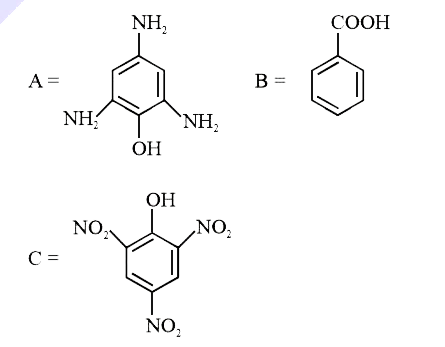When water is added to compound (A) of calcium, solution of compound (B) is formed. When carbon dioxide is passed into the solution, it turns milky due to the formation of compound (C). If excess of carbon dioxide is passed into the solution milkiness disappears due to the formation of compound (D). Identify the compounds A,B,C and D. Explain why the milkiness disppears in the last step.
When CO2 gas is passed through solution of compound B, it turns milky, therefore , solution of compound B is Ca(OH)2.
The milkiness is due to the formation of CaCO3(C). Since compound B is obtained by dissolving compound (A) in water , compound A must be quick lime , CaO. The reactions are :
CaOCalcium oxide (A)+H2O→Ca(OH)2Lime water(B)
Ca(OH)2+CO2→CaCO3Calcium carbonate (C) (Milkiness)+H2O
Milkiness disappears on passing excess CO2 because of the formation of soluble calcium bicarbonate.
CaCO3+CO2+H2O→Ca(HCO3)2Soluble (D) Milkiness disappears
Topper's Solved these Questions
- S-BLOCK ELEMENTS ( ALKALI AND ALKALINE EARTH METALS ) BOOK - MODERN PUBLICATIONCHAPTER - S-BLOCK ELEMENTS ( ALKALI AND ALKALINE EARTH METALS ) EXERCISE - Revision Exercises (Objective/Very Short answer questions (Passage Based Questions) )
8 Videos
- S-BLOCK ELEMENTS ( ALKALI AND ALKALINE EARTH METALS ) BOOK - MODERN PUBLICATIONCHAPTER - S-BLOCK ELEMENTS ( ALKALI AND ALKALINE EARTH METALS ) EXERCISE - Revision Exercises (Objective/Very Short answer questions(True or False Questions ))
10 Videos
- S-BLOCK ELEMENTS ( ALKALI AND ALKALINE EARTH METALS ) BOOK - MODERN PUBLICATIONCHAPTER - S-BLOCK ELEMENTS ( ALKALI AND ALKALINE EARTH METALS ) EXERCISE - NCERT FILE ( NCERT Exemplar Problems (Assertion and Reason Type Questions ))
2 Videos
- REDOX REACTIONS BOOK - MODERN PUBLICATIONCHAPTER - REDOX REACTIONS EXERCISE - COMPETITION FILE (Objective Questions) (C. MULTIPLE CHOICE QUESTIONS)
9 Videos
- SOME BASIC CONCEPTS OF CHEMISTRY BOOK - MODERN PUBLICATIONCHAPTER - SOME BASIC CONCEPTS OF CHEMISTRY EXERCISE - COMPETITION FILE (INTEGER TYPE AND NUMERICAL VALUE TYPE QUESTIONS)
10 Videos
Similar Questions
Fill in the blanks in the following statements:
When carbon dioxide is passed through lime water, it turns milky due to the formation of ______.
View SolutionFill in the following blanks with suitable words :
When carbon dioxide is passed through lime water. It turns milky due to the formation of ______.
View Solution
Knowledge Check
When carbon dioxide is passed through clear lime water solution, it turns milky. The milky appearance of lime water is due to
APresence of impurities in lime waterBPresence of insoluble calcium carbonateCPresence of soluble calcium carbonateDCurdling of milk due to lime in lime waterWhen carbon dioxide is passed . through clear lime water solution then it turns milky. The milky appearance of lime water is due to
Acurdling of milk due to lime in waterBpresence of impurities in lime waterCpresence of Insoluble calcium carbonateDpresence of soluble calcium carbonateWhen carbon dioxide is passed through clear lime water solution then it turns milky, The milky appearance of lime water is due to
Acurdling of milk due to lime in waterBpresence of impurities in lime waterCpresence of insoluble calcium carbonateDpresence of soluble calcium carbonate
What is the nature of the solution obtained when carbon dioxide gas is passed into water ?
View SolutionWhen carbon dioxide is passed through lime water, the solution turns milky, but, on prolonged passage, the solution turns clear. This is because
View SolutionWhen carbon dioxide is passed through lime water, a milky white precipitate of ___________is formed.
View SolutionWhen chlorine is passed through concentrated NaOH solution, the compound formed is
View SolutionCompound(s) which will liberate carbon dioxide with sodium bicarbonate solution is/are:

View Solution
